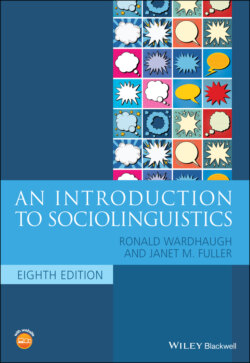Читать книгу An Introduction to Sociolinguistics - Ronald Wardhaugh, Janet M. Fuller - Страница 65
3 Defining Groups KEY TOPICS
ОглавлениеHow to define a speech community – regions, users, and norms
How to define a community of practice – interactions
Social network features and configuration
Social identity and group membership
How beliefs about groups of speakers and their languages shape how we speak
Language is both an individual phenomenon and a societal phenomenon. We look at the language of individuals and take into account their personal experiences, attitudes, and motivations for using language in different ways. But these individuals do not live in a vacuum, they are members of social groups, communities, cultures, and societies, so we are also concerned with how language use is influenced by membership in social groups. The material we cover in this chapter revolves around the underlying question of, how can we define and demarcate social groups? There are two broad aspects to this; what is meaningful for language users in terms of their sense of belonging and identification, and what is a meaningful way for sociolinguists to conceptualize and operationalize groups for the study of language use. As we’ll see in the following sections, sociolinguists talk about groups in different ways, and these contribute different things to sociolinguistic research and our understanding of language variation.
We must remain aware that the groups we refer to in various research studies are often groups we have created for the purposes of our research using this or that set of factors. They are useful and necessary constructs but we would be unwise to assume that speakers themselves would also define their group membership along the same lines.
Further, we must be careful about our interpretation of the data from these groups. It is difficult to draw conclusions about individuals on the basis of observations we make about groups that we have defined for our research purposes. Furthermore, to say of any member of such a group that he or she will always exhibit a certain characteristic behavior is to offer a stereotype. We talk about such stereotypes as being part of essentialism, the idea that people can be placed into fixed social categories and that all members we assign to a category share certain traits which we see as the essence of this category. What sociolinguists (and social scientists) seek to do is not to make such generalizations, but to discover patterns in data which link social factors with language use without ignoring variation within groups and the specific practices and experiences that make up individual identities.
After our discussion of speech communities, social networks, and communities of practice, we will link these ideas about how we might define social groups with a framework for studying social identities in order to provide a bridge between individual repertoires and social categories. The final section of this chapter then moves on to look at how people view these social groups and the ways of speaking associated with them, looking at language attitudes, language ideologies, and perceptual dialectology studies.
